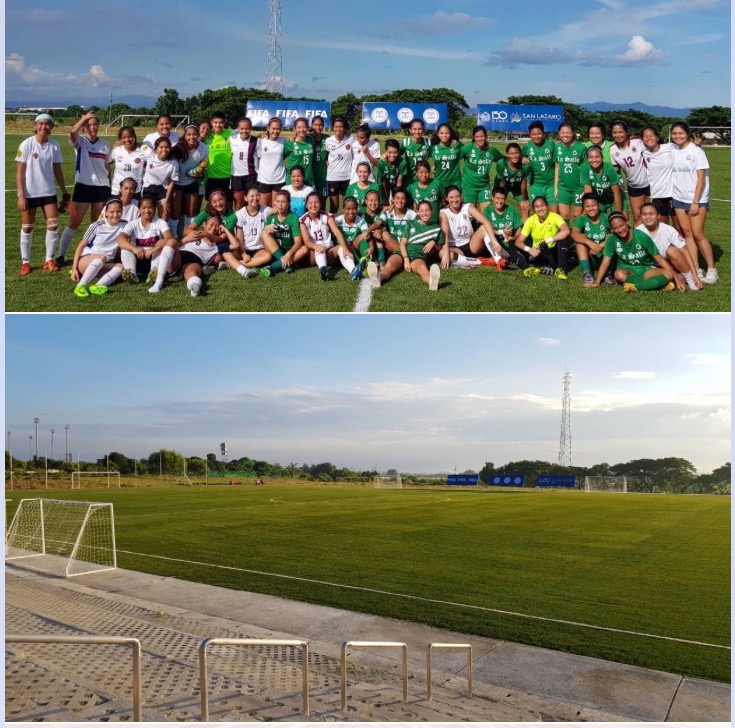Manila Jockey completes FIFA football turf in Carmona

FIFA football turf at San Lazaro Leisure & Business Park in Carmona, Cavite
The country’s premier horse racing club Manila Jockey Club Inc. (MJC) has completed a new Fédération Internationale de Football Association (FIFA)-rated football turf at the San Lazaro Leisure & Business Park in Carmona, Cavite as part of an initiative to groom this complex into the “football Mecca of the Philippines.”
The new football field – described as one of the best artificial turfs available in the country to date – was developed in partnership with the Philippine Football Federation (PFF). It will serve as the main pitch of the National Football Center, soon to be developed at San Lazaro.
The new field was inaugurated and turned over to the PFF on Sept. 9, during which MJC likewise broke ground for the PFF House of Football and National Football Center.
It is envisioned to become the training center of the national teams and host international competition, friendly matches and other related events.
“The Manila Jockey Club is proud to partner with the PFF and FIFA in building these facilities that will help raise our stature in world football. With other developments in the pipeline for Philippine football in the area, the San Lazaro Leisure and Business Park is proud to take its place as a mecca of football in this country,” MJC president Alfonso G. Reyno III said in a press statement on Friday. “Rest assured that MJC will continue to support and create programs in cooperation with the PFF toward a bigger and brighter future for Philippine football.”
Article continues after this advertisementMJC chair and chief executive officer Alfonso Reyno Jr. – together with FIFA Council member and PFF president, Mariano Araneta Jr. and PFF General Secretary Edwin Gastanes – led the official turnover ceremonies of the FIFA Football Turf.
Article continues after this advertisementIn his remarks, Araneta said: “We thank the Manila Jockey Club for their support in the creation of this new football turf, and their magnificent generosity in making the site available to us. We hope that in the future, this center will be the place where we can train and develop the next generation of football players, coaches, referees and administrators who will lift Philippine football to greater heights.”
The pitch was constructed by ACT Global, a FIFA-preferred producer of artificial turf from the United States. It is 105 meters long and 68 meters wide, the recommended size of the international body for its top level and international matches, with a present seating capacity for 1,000 to 1,200 people.
The field carries a prestigious FIFA certified two-star rating, which is the highest FIFA rating for artificial turf fields.
“The pitch is one of the best artificial turfs available in the country today,” Gastanes said.
MJC has likewise started developing the PFF House of Football, one of the ongoing infrastructure projects of the National Football Center. The four-storey building will serve as the official headquarters of the PFF which will include its corporate offices, training center and dormitories for members of the national teams attending their training camps. Future developments include two natural grass turfs, two mini artificial pitches, locker and shower rooms, gym, and a rehabilitation center available for injured and recovering players.
After the launch, the first football matches were held on the pitch: a women’s football friendly between the University of the Philippines and the De La Salle University, and an official Ang Liga men’s football match dominated by National Collegiate Athletic Association (NCAA) Champions, San Beda College against the UAAP University Athletic Association of the Philippines (UAAP) Champions, Ateneo de Manila University.
The event coincided with Manila Jockey Club’s 150th Anniversary celebration this year. Established in 1867, it is one of the oldest existing racing clubs in the Asia Pacific region.
The partnership with the PFF pays tribute to MJC’s heritage as one of the earliest football clubs in the country. In the early 1900s, MJC had its own football club formed after the Philippine-American War which competed with local teams such as the Manila Sporting Club, Paris Club, Sandow Athletic Club and the Bohemian Sporting Club.